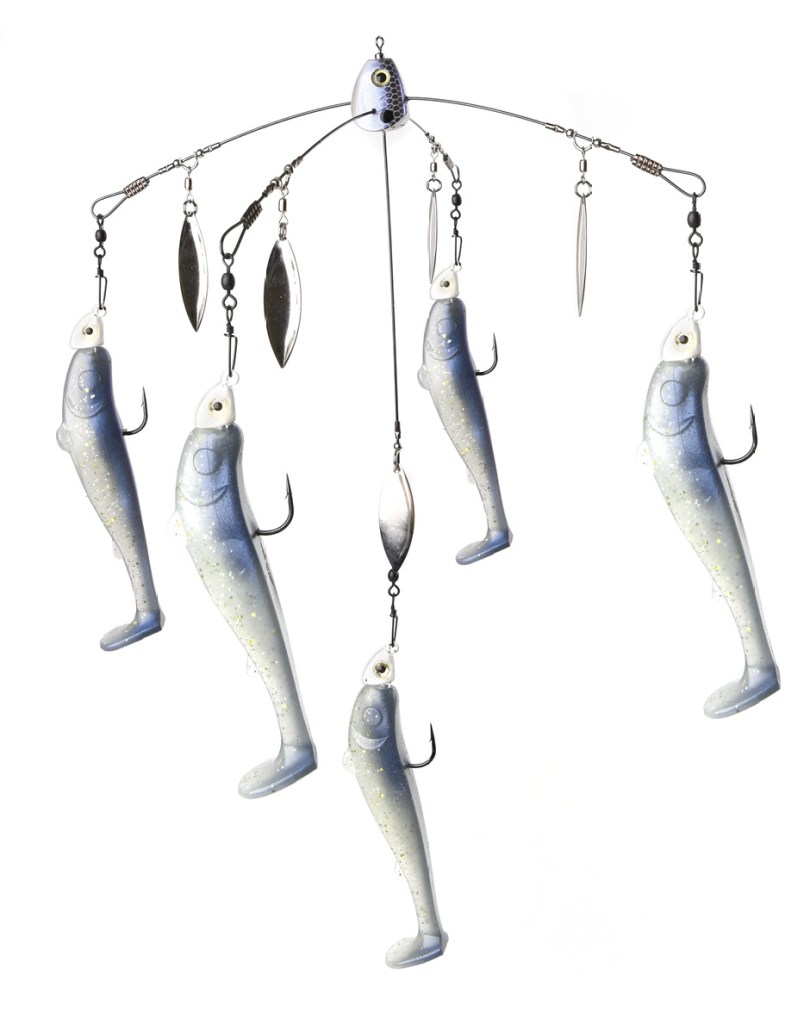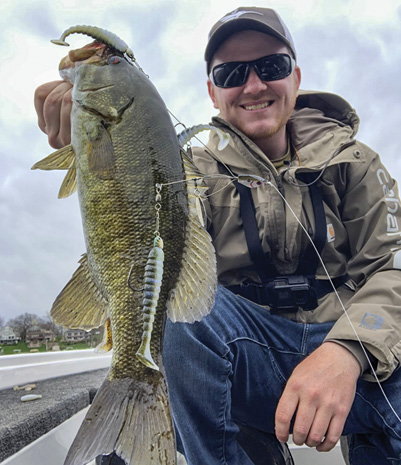
The first time Mark Zona got a smallmouth bite in northern Michigan on an umbrella rig, he couldn’t contain himself.
“Oh my God,” recalls Zona, host of Zona’s Awesome Fishing Show and The Bassmasters TV co-host. “It was one of the most ferocious strikes I’ve ever gotten from a bass. It was mind-blowing.”
A few years have passed since that big revelation occurred on a brisk fall day, but you can bet Zona has an umbrella rig on his deck anytime he heads north during the fall.
What is an umbrella rig? It consists of a lead head with multiple wires sprouting out behind in an umbrella-like configuration. Small jigs, rigged with swimbaits, are attached to the wires, and the rig is pulled through the water to resemble a school of baitfish.
Larry Mazur of Elma, N.Y., is another umbrella rig believer. Although he fishes primarily on Lake Erie — and uses the rig just about year-round — he discovered its potency on New York’s Lake Oneida.
“I used it in shallow water on Oneida in a tournament and loved it,” he remembers. “I tied it on during practice for my next tournament on Erie and caught 6-2 and 4-10 smallmouth. I knew I was onto something.”
Mazur says most people who fish Erie use tube jigs and drop shots, which will catch plenty of smallmouth. But when it comes to catching big smallmouth consistently, he says the umbrella rig is tough to beat.
“The bite is so addicting, too,” adds Mazur, who estimates he’s caught over 500 smallmouth weighing 5 pounds or more using the rig on Erie, the St. Lawrence River and other inland lakes.
Indeed, the rig works just about anywhere you find big smallies putting on the feed bag in the fall. Zona says the good umbrella rig bite in his area usually begins in shallow water around early September and lasts to about the second week of October. Once the water temps get into the low 50s, it moves to deeper water.
Once believed to be a deep-water tactic, the umbrella rig can be equally deadly when the bass are foraging on shallow flats in early fall. He says it’s as powerful shallow as a bladed jig, spinnerbait or jerkbait that time of year.
However, he notes, the transition from shallow to deep can happen quickly.
“When the bait leaves the flats, the bass move deeper and you can catch them out there until the lakes freeze,” he explains. “Just look for balls of bait offshore and sling the [umbrella] rig out around them.”
As a caveat, he adds, it tends to work best on lakes where alewives, shiners and yellow perch provide the primary forage in the fall.

The rig
It’s important to balance the rig with your jigheads. For example, Zona places lighter Strike King Baby Squadron jigheads on the top wires with slightly heavier ones on the bottom to serve as a keel when he’s moving it fast. His basic rig has 3/16-ounce jigheads on all wire leads and a 1/4 ounce below. As the water gets colder, he slows his presentation and will go to 1/8-ounce jigs, top to bottom.
“I’ve found if I go too heavy, I’ll have to move the rig too fast,” he says. “I’ll rig with Strike King Rage Swimmers in pro blue or ayu. I like 3.75 sizes early, but when the bass get on smaller bait later in the fall, I go with the 3.25.”
He also will dye the tail chartreuse on one of his swimbaits — usually the one in the middle.
“Maybe it’s all mental, but I think it matters,” he says.
Umbrella rigs come with and without tiny spinner blades added. Zona prefers those without but says there are times when the bladed umbrella rigs work better. Experiment, he adds.
He fishes it on the Lew’s Hackney Frog Rod, a 7-3 graphite rod with a soft tip and good backbone. His reel is a 7:1 Lew’s HyperMag spooled with 20-pound Seaguar Tatsu fluorocarbon.
“It’s imperative to make long casts; it’s exhausting but helps you cover water effectively,” insists Zona, who was using Strike King Titanium A-Rigs for five-wire presentations. He’s also taken a liking to Frenzy Baits’ The Sniper for fishing with seven wires but uses dummy baits on two of the wires.
Many states limit the number of hooks allowed on an umbrella rig. “Dummy” swimbaits are fastened on jigheads without hooks or on Hitchhikers that twist onto the lure head.
“The extra baits give the rig the look of a larger baitfish school,” explains Zona.
The retrieve can be critical to how many bites you get. In shallow water, Zona winds as fast as he can.
“I’ll wind it along, then turn the reel handle quickly a few times to make the baits flare,” he describes. “When out deep in late fall, I’m scratching the bottom, occasionally making it flare.”
Mazur fishes similarly but takes it to the extreme. Because the wind blows often on Lake Erie, he will bomb the rig out past the fish he sees on his electronics, release his baitcast spool until he knows the rig is at the right depth, then drift with the wind.
“It’s sort of like long lining,” he says. “The key is to keep the rig just above the fish but don’t let it rise too much.”
His winding is slow, and like Zona, he will pop it on occasion to make it flare.
He uses a similar jig setup. In 50 feet or more, he puts two 1/8-ounce jigheads on top, with a 1/4-ounce jighead below. He always uses Keitech Swing Impact FAT Swimbaits in sizes 3.3, with a 3.8 in the middle. He uses a variety of colors but always puts the electric blue chartruese color in the middle.
“For some reason, that’s the one they hit,” explains Mazur. “I’ve tried using all of that color, but it doesn’t work as well. They key on the one different bait.”
He prefers the Brown Dog Tackle Co. umbrella rigs with blades and fishes them on a G. Loomis IMX-PRO 915C Umbrella Rig Rod and an Abu Garcia Revo Beast spooled with 20-pound Trilene 100% fluorocarbon line.
“Tighten the drag all the way down,” he advises. “When long lining for big smallmouth and setting the hook from a distance, you need to get those buried.”
And yes, it’s not unusual to have more than one smallmouth hit your bait simultaneously.
“I’ve shot Zona shows in which I had all the footage I needed in 10 casts,” he says. “It’s amazing how ferocious those big schools of fish can be. They hit like a big muskie or saltwater fish.”
Yes, hurling that wiry passel of swimbaits can wear you out and create a tangled mess on the boat deck. But, when you get around schools of big smallmouth this fall, there may not be anything better to sling their way.
Swimbait options
Plastics can vary in size and color for a versatile look.
Jighead
Heads can match to give the look of a school or differ for variety.
Blade
Blades provide extra flash to induce strikes.
Umbrella rig head
The main head provides weight and represents the school leader.
Swivel/snap
Swivels allow the swimbaits to move freely, and snaps allow for quick changes.

Umbrella riggin’ river smallies
Umbrella rigs aren’t just for big-water smallmouth.
They can be just as effective in rivers, especially those connected to the Great Lakes, says Bill Mathews, Southwest Michigan College coach and avid smallmouth angler.
He’s a perennial threat to win fall tournaments on the St. Joseph River. The river empties into Lake Michigan at Benton Harbor, Mich.
And he usually does it with an umbrella rig.
“If you’re not throwing it in a fall tournament, you’re losing,” insists the Dowagiac, Mich., angler.
The St. Joseph River has resident smallmouth, but cooling fall waters lure baitfish and bigger Lake Michigan bruisers into the lower river once the water temperature drops into the low 60s.
“Whenever the bait moves into the river, it happens,” he says. “The smallmouth will follow them all the way to the next dam.”
He keeps his rig simple. He uses the Yumbrella Jr. rig, with blades on cloudy days and without on sunny days.
He puts 3/16-ounce jigheads on the two top and middle wires and 1/4 ounce on the bottom. He uses 3.3 swimbaits — Strike King Rage Swimmers or Keitechs.
“I really like shad colors, but alewife can play at times,” he notes.
When up the river, he’s usually fishing shallow, but he will catch them around bridge pilings and other current breaks downriver near Lake Michigan.
His retrieve is simple as well.
“I wind it straight and sometimes burn it, then kill it, to get a fish to react,” he describes.
Originally appeared in Bassmaster Magazine 2024.





